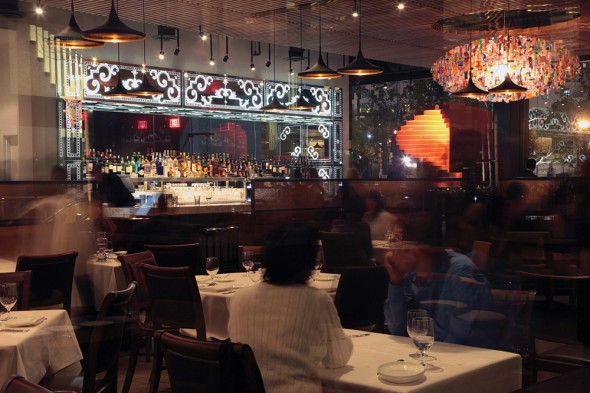
Chaya
The Rebirth of Downtown LA has people asking,
“Who’s LA’s Publicist?”
Downtown LA was once a city of grime and Skid Row, crack addicts and street walkers; not to mention, the best place to buy a knock-off Rolex. But now, the historically-noir town has become revamped, its image transformed by cleaning up the streets and providing a hefty supply of loft developments, art gallery gatherings, and impressively exquisite restaurants.
Until recently, Angelenos and out-of-towners alike only knew of the murky city as the place that catered to the Financial District and a lackluster garment industry. In the past few years, however, while some sat back and laughed at the thought of such a transformation, investors and developers soon began revolutionizing this Gotham City.
For a true dining treat, CASA on South Grand Ave. offers traditional Mexican food with a dash of modern influence. Grounded in the progressive architecture of a contemporary hacienda setting, Chef Kris Morningstar prepares seasonal soulful tapas-style dishes that are delectable yet reasonably priced. The considerably large patio connects One and Two California Plaza, ornamented with a water feature and fire table. The outdoor casitas are a perfect addition to the space for enjoying the beautiful weather that LA has to offer.
However if one is in the mood for a more elegant night out, CHAYA recently opened its doors on Navy Street to a discernable downtown clientele. Chef Shigefumi Tachibe offers fresh sushi and sashimi, as well as traditional Chinoiserie fare to delight the senses. This is CHAYA’s fourth restaurant in California, incorporating art deco details throughout, as well as an opulent chandelier in the entrance. Even with the current economic flux, the trendy, dynamic restaurant is packed with diners, and those wanting to unwind over a palatable cocktail after work.

CASA
Nestled at the top of South Grand Avenue one can find the Museum of Contemporary Art. In October 2008, the MOCA launched local artist collectives with three-month residencies on the first Thursday evening of every month, allowing for a public unveiling of the featured artists. The initiative to fuse LA-based collectives with the public has been thusly named “Engagement Party,” and the programs have incorporated a diverse spectrum of mediums and disciplines. These interactive collectives typically consist of lectures, screenings, workshops, or highly unique performance art.
At the heart of these “Engagement Parties” is MOCA’s interest in defying traditional roles that most museums practice by shedding light on the importance of an artistic collective, and viewing art as a dialogue rather than a profitable product. The most recent art collective, “Knifeandfork,” installed a custom golf course that circumvented the museum’s physical boundaries, using both interior and exterior spaces that follow multiple paths through MOCA’s Grand Avenue grounds.
If a smaller art venue with an intimate gathering is preferred, Charlie James Gallery in Chinatown can be found just a few streets away. Recently, the gallery showcased the works of Iranian American artist Taravat Talepasand. Talepasand’s work is the juxtaposition of cultural stereotypes with a westernized approach, which she says is her “double life.” The space caters to artists from all around the globe, and is another unique aspect that the city has to offer.
Stretching along the rooftops of downtown, you can find a progressive brew of politics, art, film, and music dubbed “Banned Movie Night.” This monthly film screening exposes films that have been banned by the U.S. Government for unconstitutional intent in the past. The collective then donates proceeds to Doctors Without Borders, a non-profit NGO known for its outstanding humanitarian work. In addition to the celluloid projected, a DJ holds court, spinning tunes for like-minded activists exchanging ideas for what may be the next great cause.
– Natalie Shirinian & Michelle Peerali

